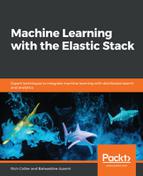Once a model has been constructed, the likelihood of any future observed value can be found within the probability distribution. As described earlier, we had asked the question, "Is getting fifteen pieces of mail likely?". This question can now be empirically answered, depending on the model, with a number between zero (no possibility) and one (absolute certainty). ML will use the model to calculate this fractional value out to approximately 300 significant figures (which can be helpful when dealing with very low probabilities). Let's observe the following graph:

Here, the probability of the observation of the actual value of 921 at this point in time was calculated to be 6.3634e-7 (or more commonly a mere 0.000063634% chance). This very small value is perhaps not that intuitive to most people. As such, ML will take this probability calculation, and via a process of quantile normalization, re-cast that observation on a severity scale between 0 and 100, where 100 is the highest level of unusualness possible for that particular dataset. In the preceding case, the probability calculation of 6.3634e-7 was normalized to a score of 94. This normalized score will come in handy later as a means by which to assess the severity of the anomaly for purposes of alerting and/or triage.
